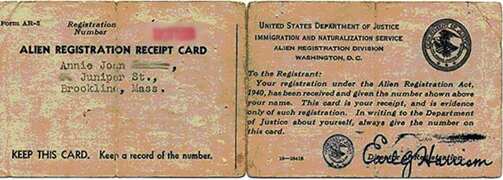Chapter 1 - Purpose and Background
A. Purpose
A lawful permanent resident (LPR) is an noncitizen who the U.S. government has lawfully authorized to permanently live in the United States.[1] LPRs are issued a Permanent Resident Card (PRC)[2] as evidence of identity and status in the United States.[3]
B. Background
In general, LPRs initially receive a PRC after USCIS approves their Application to Register Permanent Residence or Adjust Status (Form I-485) or after U.S. Customs and Border Protection admits them into the United States as an LPR following consular processing abroad.[4] LPRs 18 years of age and over are required to carry their PRCs (or other equivalent proof of registration) at all times.[5]
LPRs use the Application to Replace Permanent Resident Card (Form I-90) to request that USCIS replace their PRC.[6] Form I-90 should also be used to obtain a PRC when an applicant has been automatically converted to permanent resident status.[7] Eligible LPRs also use Form I-90 to request taking up “commuter status” or to resume actual residence in the United States after having been in commuter status.[8]
History
The principle of registering and fingerprinting noncitizens was established in the Alien Registration Act of 1940 (Smith Act).[9] The Smith Act required all noncitizens in the United States 14 years of age or older who remained in the United States 30 days or longer to register and be fingerprinted with the U.S. government before such 30 days were over, whether they were present lawfully or unlawfully, temporarily or permanently. These registered noncitizens were issued an Alien Registration Receipt Card (Form AR-3).

Alien Registration Receipt Card (Form AR-3).
Courtesy of the USCIS History Office and Library.
This card was later revised as AR-3A and AR-103.
In 1946, the U.S. government began issuing different types of registration documents based upon the status of the noncitizen in the United States. LPRs were issued Form I-151 (Alien Registration Receipt Card), which contained a green tint and led to the card being commonly referred to as a “green card.”
In 1977, the PRC (Form I-551) replaced the Form I-151 as evidence of LPR status. In 1989, the Immigration and Naturalization Service (INS) introduced the second version of the PRC, usually with an expiration date of 10 years after the date of issuance.[10] USCIS has continued to improve the PRC by using the latest tamper-resistant technology.[11]
C. Legal Authorities
-
INA 101(a)(20) – Definition of lawfully admitted for permanent residence
-
INA 262 – Registration of aliens
-
INA 264 – Forms for registration and fingerprinting
-
8 CFR 264.5 – Application for a replacement Permanent Resident Card
-
8 CFR 211.5 – Alien commuters
Footnotes
[^ 1] Certain LPRs may commence or continue to reside in Mexico or Canada and commute to their place of employment in the United States. For more information, see Chapter 4, Commuter Cards [11 USCIS-PM B.4].
[^ 2] A Permanent Resident Card is also called a Form I-551 or a green card.
[^ 3] Certain noncitizens obtain lawful permanent residence on a conditional basis and are known as conditional permanent residents. A person (and his or her children) whose qualifying marriage to their petitioning spouse is less than 2 years old at the time of admission or adjustment of status obtain lawful permanent residence on a conditional basis. See INA 216. Immigrant investors (and their spouses and children) may also obtain lawful permanent residence on a conditional basis based on qualifying entrepreneurship. See INA 216A. See Volume 6, Immigrants, Part G, Investors [6 USCIS-PM G].
[^ 4] For information on consular processing, see Volume 7, Part A, Adjustment of Status Policies and Procedures, Chapter 1, Purpose and Background, Section A, Purpose [7 USCIS-PM A.1(A)].
[^ 5] See INA 264(e).
[^ 6] Form I-90 generally may not be used to request an initial PRC. For example, noncitizens who are granted LPR status by an immigration judge, or an LPR mother who needs a PRC for a child (under 2 years of age) born while the mother was temporarily abroad, should not file Form I-90 to request an initial PRC. The USCIS field office with jurisdiction over such an applicant’s residence may be able to assist the applicant to obtain an initial PRC at an INFOPASS appointment. For more information, applicants may call the USCIS Contact Center at 1-800-375-5283 (TTY for applicants who are deaf, hard of hearing, or have a speech disability: 1-800-767-1833).
[^ 7] For example, special agricultural workers who automatically adjusted to permanent residence based on INA 210 must file Form I-90 in order to obtain a PRC.
[^ 8] For more information, see Chapter 4, Commuter Cards [11 USCIS-PM B.4].
[^ 9] See 54 Stat. 670 (June 28, 1940).
[^ 10] Exceptions to a 10-year card include, for example, conditional permanent residents for whom legacy INS began issuing Forms I-551 with an expiration date of 2 years after the date on which the person became a conditional permanent resident under the Immigration Marriage Fraud Amendments of 1986, Pub. L. 99-639 (PDF) (November 10, 1986). See Chapter 2, Replacement of Permanent Resident Card, Section C, Conditional Permanent Residents [11 USCIS-PM B.2(C)] for more information.
[^ 11] For example, in May 2017, USCIS began issuing redesigned permanent resident cards with enhanced security features.
